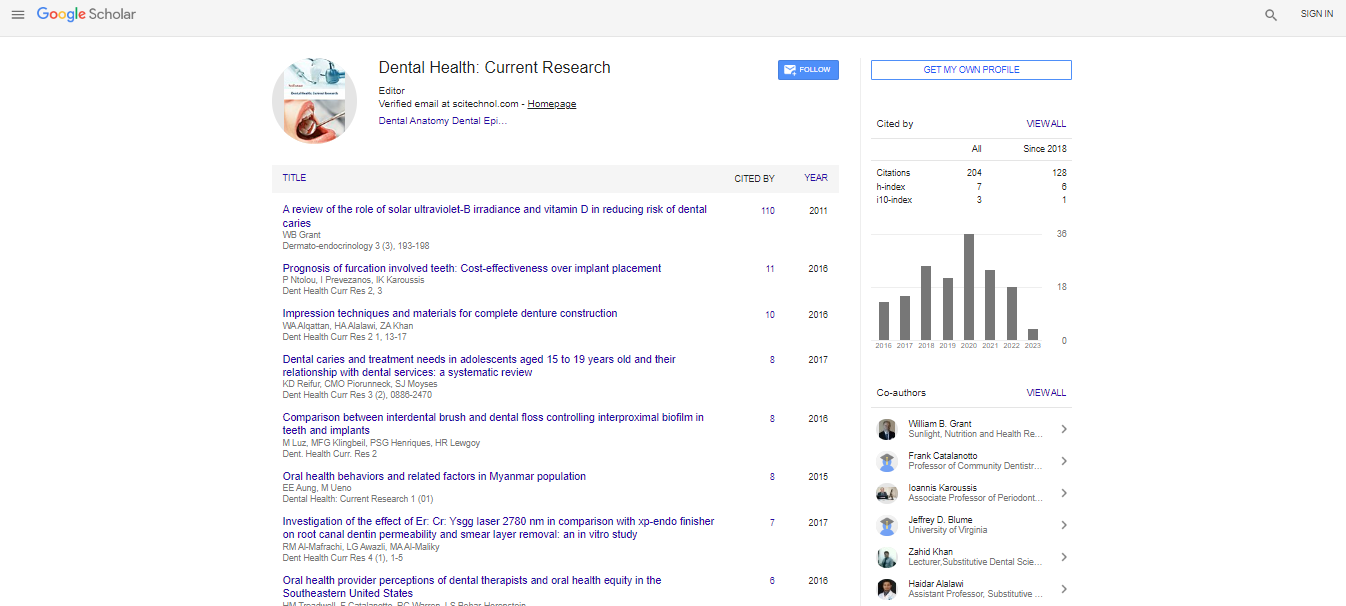Implant Surgery and Assistant Guide: An approach towards Surgery and assistant understands
Hee Ja Na
Honam University, Korea
: Dent Health Curr Res
Abstract
Objectives: This study introduces the assistance process of dental hygienists during an implant surgery. The purpose of the study is to promote high-quality implant surgery assistance in order to increase the success rate of implant surgeries. Background: Dental hygienists are service providers with experience, abilities, and a service-oriented mindset. Dental hygienists analyze and confirm the medical history of patients who attend the dental clinic, observe these patients' overall health, and take quick measures when an infectious condition is found in order to cut off the infection path and avoid infection within the dental office. Materials and Method: The authors introduce the implant surgery procedures during the treatment of patient K, who visited Y Dental Department in City G in January of 2020. Surgical procedures and cautions with a focus on the assistance of dental hygienists during a surgery are listed. The roles of a surgical assistant; patient management during surgery; assistive roles in soft tissue incision, retraction, bond preparation, and implant placement; cases that give special attention to suctioning; and medical assistance including sutures are introduced with pictures and explanations. Results: Dental hygienists must maintain accuracy, agility, and composure along with the practitioner when providing assistance. In addition, dental hygienists’ medical assistance affects the amount of time required for surgery; occurrence of trauma during surgery, post-surgery edema and pain, and post-surgery infection; and surgery failure rate. The role of a dental hygienist in assisting implant surgeries is essential. A patient-centered assistance is important, and a dental hygienist must maintain the patient's comfort level and psychological stability through communication with the patient. Conclusion: In cases of soft tissue incisions, the assistant should cautiously secure the field of view with the mirror using the left hand and the suction tip using the right hand at a right angle to the soft tissue surface. The assistant checks with the patient whether there is any discomfort when the incision begins. The incision is checked using a periosteal elevator. The suction tip is positioned close to the site of the procedure while the valve is lifted. The purpose of retraction is to secure the view of the surgical site. The retractor is placed at a right angle to the bone surface, neither pressing on soft tissue nor slipping. When the retractor presses on the foramen, the resulting pressure to the nerves causes sensory abnormalities. Before removing the bone, the patient is instructed to slightly raise a hand or to speak if he/she feels pain or tingling. The patient is asked to breathe through the nose as there will be a continuous flow of water, which will be sucked away with suction. If the assistant were to directly spray saline on the site of the procedure, then it is sprayed on the area where the drill meets the bone surface while simultaneously administering an appropriate amount of suction. It is recommended to place the suction tip around 5 mm below the drill. The retractor is stabilized by placing it perpendicular to the bone surface ne surface. It is better for the patient's blood to first come into contact with the implant. Saline should not be sprayed until a one third of the implantation is completed. The cooling effect should be maintained by suctioning around 5 mm away while spraying the saline solution. The patient must be instructed to open the mouth as wide as possible, and caution must be taken to ensure there is no contact with the implant during the use of a metal tip. Suction should be performed at proximity while checking the placement depth. During the connection of healing abutments or cover screws, the grooves of the connecting parts should be washed and suctioned with saline to remove any blood. After the implant insertion, the patient must be informed about the progress of the operation and calmly reassured about his/her recovery. During tap drill, the patient is instructed to open the mouth wide so that the drill does not touch the opposite side when it is removed in reverse rotation. It is important not to allow foreign substances near the implant and to provide sufficient retraction while inserting the implant. Rolled gauze is hold with a mosquito and pressure should be applied during bone grafts, soft tissue grafts, crushed bone fragments, collagen shields, and shielding procedures. The suction tip is kept slightly away from the window boundary and it should not enter the window during the maxillary sinus graft. When the implant is inserted to an extent, saline is sprayed and suctioned with the suction tip placed at an approximate distance of 5 mm from the implant. The inner groove of the implant connection is washed with saline and suctioned. The connection groove is clean, the cover screw is connected. Bone defects are visible in the buccal cavity. A bone transplant was performed using BioOss, a crushed bone type of graft. The suction tip should never be allowed to make contact with the bone graft material. During the suture, the left hand should be used for retraction while holding the mirror, whereas the right hand should be used to hold the suction or tamponed. Clinical Relevance: Introducing dental hygienist assistance and protocols for implant surgery.
Biography
Hee Ja Na, is from Department of Dental Hygiene at Honan University, Kwangju, 62399, Korea. And she is an associate professor of dental hygiene at Honam University. Her Academic Experience at Director of the Korean Society of Preventive Dentistry, Editorial Director of the Korean Society of Preventive Dentistry and Preventive dentistry, orthodontics, implants. Her Research Area at Republic of Korea, Excellent teacher for research papers at Honam University.
 Spanish
Spanish  Chinese
Chinese  Russian
Russian  German
German  French
French  Japanese
Japanese  Portuguese
Portuguese  Hindi
Hindi 